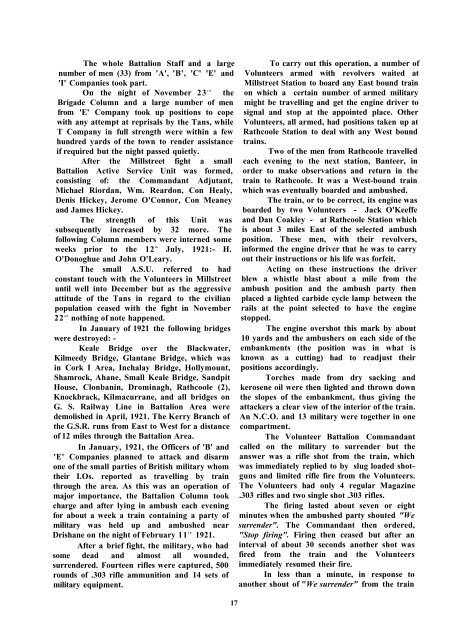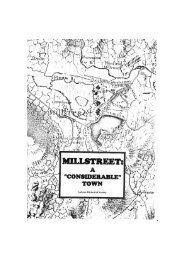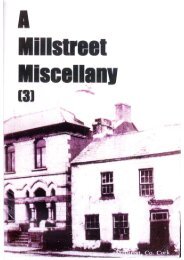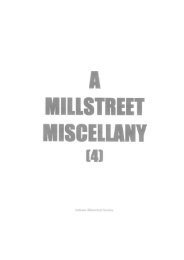The 'Boys' Of The Millstreet Battalion Area - Aubane Historical Society
The 'Boys' Of The Millstreet Battalion Area - Aubane Historical Society
The 'Boys' Of The Millstreet Battalion Area - Aubane Historical Society
You also want an ePaper? Increase the reach of your titles
YUMPU automatically turns print PDFs into web optimized ePapers that Google loves.
<strong>The</strong> whole <strong>Battalion</strong> Staff and a large<br />
number of men (33) from 'A', 'B', 'C' 'E' and<br />
'I' Companies took part.<br />
On the night of November 23 rd<br />
the<br />
Brigade Column and a large number of men<br />
from 'E' Company took up positions to cope<br />
with any attempt at reprisals by the Tans, while<br />
T Company in full strength were within a few<br />
hundred yards of the town to render assistance<br />
if required but the night passed quietly.<br />
After the <strong>Millstreet</strong> fight a small<br />
<strong>Battalion</strong> Active Service Unit was formed,<br />
consisting of: the Commandant Adjutant,<br />
Michael Riordan, Wm. Reardon, Con Healy,<br />
Denis Hickey, Jerome O'Connor, Con Meaney<br />
and James Hickey.<br />
<strong>The</strong> strength of this Unit was<br />
subsequently increased by 32 more. <strong>The</strong><br />
following Column members were interned some<br />
weeks prior to the 12 th<br />
July, 1921:- H.<br />
O'Donoghue and John O'Leary.<br />
<strong>The</strong> small A.S.U. referred to had<br />
constant touch with the Volunteers in <strong>Millstreet</strong><br />
until well into December but as the aggressive<br />
attitude of the Tans in regard to the civilian<br />
population ceased with the fight in November<br />
22 nd<br />
nothing of note happened.<br />
In January of 1921 the following bridges<br />
were destroyed: -<br />
Keale Bridge over the Blackwater,<br />
Kilmeedy Bridge, Glantane Bridge, which was<br />
in Cork I <strong>Area</strong>, Inchalay Bridge, Hollymount,<br />
Shamrock, Ahane, Small Keale Bridge, Sandpit<br />
House, Clonbanin, Drominagh, Rathcoole (2),<br />
Knockbrack, Kilmacurrane, and all bridges on<br />
G. S. Railway Line in <strong>Battalion</strong> <strong>Area</strong> were<br />
demolished in April, 1921. <strong>The</strong> Kerry Branch of<br />
the G.S.R. runs from East to West for a distance<br />
of 12 miles through the <strong>Battalion</strong> <strong>Area</strong>.<br />
In January, 1921, the <strong>Of</strong>ficers of 'B' and<br />
'E' Companies planned to attack and disarm<br />
one of the small parties of British military whom<br />
their I.Os. reported as travelling by train<br />
through the area. As this was an operation of<br />
major importance, the <strong>Battalion</strong> Column took<br />
charge and after lying in ambush each evening<br />
for about a week a train containing a party of<br />
military was held up and ambushed near<br />
Drishane on the night of February 11 th<br />
To carry out this operation, a number of<br />
Volunteers armed with revolvers waited at<br />
<strong>Millstreet</strong> Station to board any East bound train<br />
on which a certain number of armed military<br />
might be travelling and get the engine driver to<br />
signal and stop at the appointed place. Other<br />
Volunteers, all armed, had positions taken up at<br />
Rathcoole Station to deal with any West bound<br />
trains.<br />
Two of the men from Rathcoole travelled<br />
each evening to the next station, Banteer, in<br />
order to make observations and return in the<br />
train to Rathcoole. It was a West-bound train<br />
which was eventually boarded and ambushed.<br />
<strong>The</strong> train, or to be correct, its engine was<br />
boarded by two Volunteers - Jack O'Keeffe<br />
and Dan Coakley - at Rathcoole Station which<br />
is about 3 miles East of the selected ambush<br />
position. <strong>The</strong>se men, with their revolvers,<br />
informed the engine driver that he was to carry<br />
out their instructions or his life was forfeit.<br />
Acting on these instructions the driver<br />
blew a whistle blast about a mile from the<br />
ambush position and the ambush party then<br />
placed a lighted carbide cycle lamp between the<br />
rails at the point selected to have the engine<br />
stopped.<br />
<strong>The</strong> engine overshot this mark by about<br />
10 yards and the ambushers on each side of the<br />
embankments (the position was in what is<br />
known as a cutting) had to readjust their<br />
positions accordingly.<br />
Torches made from dry sacking and<br />
kerosene oil were then lighted and thrown down<br />
the slopes of the embankment, thus giving the<br />
attackers a clear view of the interior of the train.<br />
An N.C.O. and 13 military were together in one<br />
compartment.<br />
<strong>The</strong> Volunteer <strong>Battalion</strong> Commandant<br />
called on the military to surrender but the<br />
answer was a rifle shot from the train, which<br />
was immediately replied to by slug loaded shotguns<br />
and limited rifle fire from the Volunteers.<br />
<strong>The</strong> Volunteers had only 4 regular Magazine<br />
.303 rifles and two single shot .303 rifles.<br />
<strong>The</strong> firing lasted about seven or eight<br />
minutes when the ambushed party shouted "We<br />
surrender". <strong>The</strong> Commandant then ordered,<br />
1921. "Stop firing". Firing then ceased but after an<br />
After a brief fight, the military, who had interval of about 30 seconds another shot was<br />
some dead and almost all wounded, fired from the train and the Volunteers<br />
surrendered. Fourteen rifles were captured, 500 immediately resumed their fire.<br />
rounds of .303 rifle ammunition and 14 sets of In less than a minute, in response to<br />
military equipment.<br />
another shout of "We surrender" from the train<br />
17





